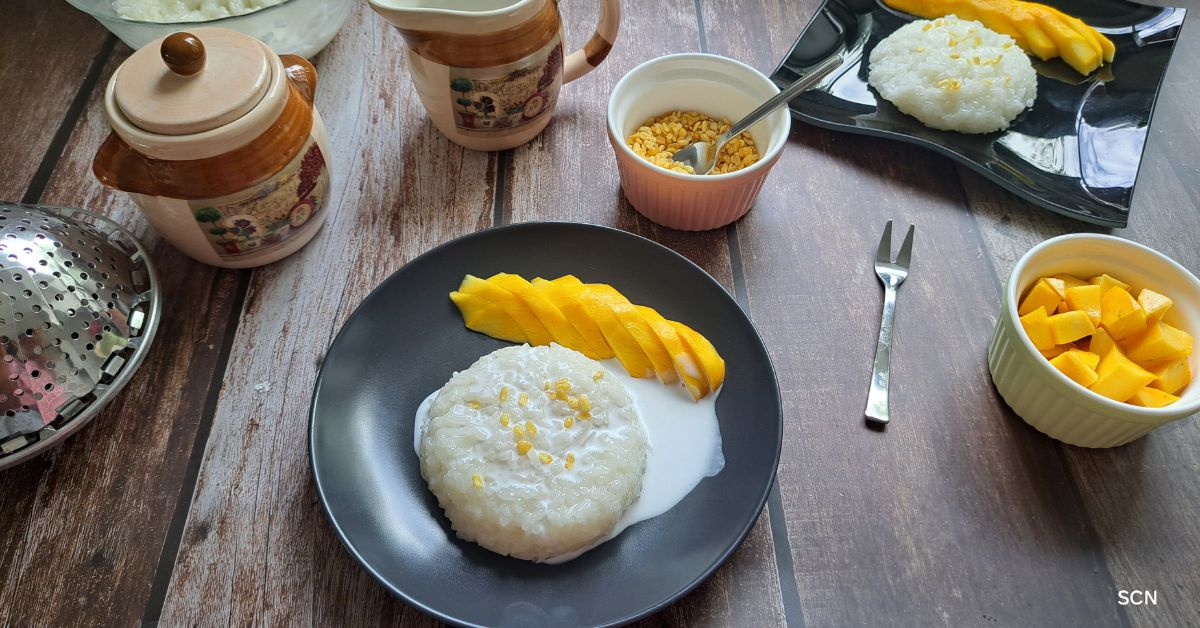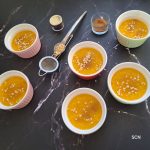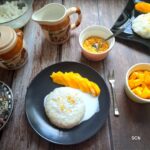Thai Mango sticky rice

Thai Mango Sticky Rice, known as “Khao Niew Mamuang” in Thai, is a dessert in Thai cuisine that beautifully captures the essence of the country’s tropical flavours. This dish combines the natural sweetness of ripe mangoes with coconut-infused sticky rice’s rich, creamy texture.
At its core, Mango Sticky Rice is a simple yet elegant dessert, often enjoyed during Thailand’s mango season, which peaks between April and June. Sticky rice, made from glutinous rice, is steamed and soaked in sweetened coconut milk to absorb rich flavours and a creamy texture. This is paired with fresh slices of ripe mango, which add a refreshing, juicy contrast to the slightly salty and sweet rice.
What makes Mango Sticky Rice particularly special is its reflection of Thai culture, where rice is a staple and coconut is a prominent ingredient in many dishes. You can serve them at room temperature, making it an ideal treat for Thailand’s warm climate. It’s enjoyed both as a street food delicacy and as a dessert in high-end restaurants. You can use Mung beans as a topping for Thai mango sticky rice to add a bit of crunch and contrast to the sweet and creamy dish.
Glutinous rice:
The type of rice used for Thai mango sticky rice is glutinous rice, also known as sticky rice or sweet rice. This specific variety of rice is essential for achieving the dish’s characteristic texture and flavour. Glutinous rice is named for its sticky, glue-like texture when cooked. The term “glutinous” refers to its sticky nature. The grains of glutinous rice are short and plump, with a milky, opaque appearance when raw. When cooked, the rice turns translucent and has a soft, chewy texture. Glutinous rice has a mild, slightly sweet flavour that complements the rich coconut milk and sweet mangoes in Thai mango sticky rice.
Soak the Glutinous rice in water overnight before cooking. This step helps the rice cook more evenly and achieve the desired sticky texture. The soaked rice is traditionally steamed rather than boiled. Steaming preserves the rice’s sticky texture and prevents it from becoming mushy. In Thai kitchens, sticky rice is steamed in a bamboo steamer, which allows the rice to cook gently and evenly. Mix the warm sweetened coconut milk when the rice is steaming hot. The rice absorbs the coconut milk, becoming even stickier and infused with rich flavour. The result is a tender, sweet, and slightly chewy rice that pairs perfectly with ripe mango.
Where to Find Glutinous Rice?
Asian Markets: Glutinous rice is widely available in Asian grocery stores, often labelled as “sweet rice” or “sticky rice.”
Online: It can also be purchased from various online retailers specializing in Asian ingredients.
Using the right type of rice is crucial for making authentic Thai mango sticky rice.
Comparison of Coconut Usage in Thailand and Southern India:
Thailand and Southern India share a deep culinary connection with coconut. However, each region uses it in unique ways that reflect their distinct flavours and cultural traditions.
Thailand: In Thai cuisine, coconut is integral to both sweet and savoury dishes. It’s a staple in traditional cooking and is deeply embedded in the culinary identity of the country. Coconut milk is essential in creating rich, creamy bases for curries, soups, and desserts like Thai mango sticky rice.
The most common forms of coconut used are coconut milk and coconut cream, which are key in many dishes like curries (e.g., green curry, massaman curry), soups (e.g., Tom Kha Gai (coconut soup with chicken)), and desserts (e.g., mango sticky rice). Fresh coconut water is also a popular beverage. These dishes highlight the use of coconut.
Southern India: Coconut holds a similar place of importance in the culinary traditions of Southern India, particularly in states like Kerala, Tamil Nadu, and Karnataka. Here, coconuts are used in various forms, such as grated, as coconut milk, or coconut oil.
In Southern India, coconut is utilized in multiple forms—grated coconut is added to curries, chutneys, and rice dishes. Coconut milk is used in stews like Kerala’s Ishtu and coconut oil is a primary cooking medium. Dishes like aviyal, thoran, and payasam showcase the versatility of coconut in regional cuisine. Coconut is central to dishes such as Kerala’s fish curry, coconut chutney, sambar (a lentil-based vegetable stew), and various coconut-based desserts like coconut payasam and coconut barfi.




Thai Mango sticky rice
Ingredients
For the Sticky Rice
- 1 cup glutinous sticky rice (approximately 160gms)
- Water as needed for soaking and steaming
- 1 cup coconut milk
- ½ cup sugar
- ⅛ tsp salt
For the Coconut sauce
- 1 cup coconut milk
- ⅛ teaspoon salt
- 1 tsp rice flour or cornstarch optional, for thickening
- For the mung beans:
- ¼ cup yellow mung beans peeled and split
- Water for soaking and boiling
- A pinch of salt optional
- 1 tbsp Oil for frying optional
To Serve
- 1-2 ripe mangoes peeled and sliced
- 2 tbsp toasted sesame seeds or mung beans optional, for garnish
Instructions
Prepare the Sticky rice
- Rinse the sticky rice under cold water until the water runs clear. Soak the rice in water overnight.
- Drain the soaked rice. Place it in a cheesecloth-lined steamer basket, and steam over simmering water for about 25-30 minutes until the rice is tender and translucent.
- While the rice is steaming, heat 1 cup of coconut milk in a saucepan over medium heat. Add 1/2 cup sugar and 1/8 tsp salt, stirring until dissolved. Remove from heat.
- Immediately after the sticky rice is cooked and still hot, transfer it to a large bowl.
- Gradually pour the warm coconut milk mixture over the hot rice, stirring gently to ensure all the rice is evenly coated.
- Cover the bowl with a tight lid, towel or aluminium foil and let the rice sit for about 20-30 minutes. During this time, the rice will absorb the coconut milk, becoming rich and flavourful.
Make the coconut sauce
- In a small saucepan, heat 1 cup of coconut milk over medium heat.
- Add 1/8 tsp salt, stirring until dissolved.
- If you prefer a thicker sauce, dissolve 1 tsp of rice flour or cornstarch in 1 tbsp cold water and add to the sauce. Stir until the sauce thickens slightly. Remove from heat.
Mung bean preparation (optional)
- Rinse the mung beans thoroughly under cold water.
- Place them in a bowl and cover with water. Let them soak for about 2 hours. This will soften the beans and help them cook faster.
- After soaking, drain the mung beans and rinse them under cold water.
- Bring a pot of water to a boil. Add a pinch of salt if desired.
- Add the mung beans to the boiling water and cook until they are soft but still hold their shape. The beans should be tender but not mushy.
- Once cooked, drain the beans and spread them out on a clean kitchen towel or paper towel to remove excess moisture.
- Heat a small amount of oil in a pan over medium heat.
- Add the cooked mung beans and fry them until they are crispy and golden brown. This step is optional but adds a delightful crunch to the sticky rice.
- Once fried, remove the beans from the pan and place them on paper towels to drain any excess oil.
- Let the mung beans cool completely. Once cooled, they can be stored in an airtight container until ready to use.
- When serving the mango sticky rice, sprinkle the prepared mung beans over the top of the sticky rice for added texture and flavour.
Serve
- Place a portion of the sticky rice on a serving plate.
- Arrange slices of ripe mango alongside the sticky rice.
- Drizzle with the coconut sauce.
- Garnish with toasted sesame seeds or mung beans if desired.
Notes
Frequently Asked Questions
Yes, you can prepare the sticky rice in advance, but it’s best to assemble everything before serving for the freshest taste.
If you have leftovers, store the sticky rice and mango separately in airtight containers in the refrigerator for up to 2 days. Reheat the sticky rice gently before serving.
Absolutely! While mango is traditional, feel free to experiment with other tropical fruits like bananas or strawberries for a different twist.
1 thought on “Thai Mango sticky rice”